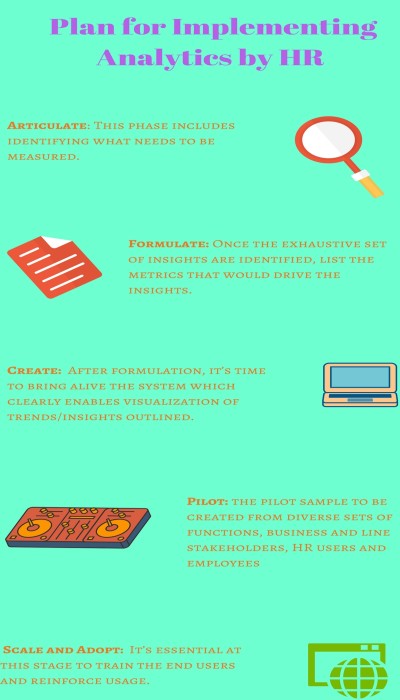HR Analytics: How to plan for implementation

“I have been hearing about HR Analytics and its importance in various forums, but I am still not clear about how to go about it,” pondered Shravya as she just came out of the meeting with senior leaders. Shravya is a senior HR manager in HR COE of a German multinational, which has laid out a clear agenda of harnessing Big Data and Analytics across its businesses. Shravya sees that marketing function has a very clear roadmap laid out on building an Analytics-based organization to generate valuable consumer insights.
She understands that it’s equally important to build an insight-driven organization for internal customers- the employees. However, usage of Analytics is not as mature in HR as it is in external consumer-facing functions. This is not because of lack of data. They have a lot of data related to the employees, but they are available in siloed segments making them unusable for generating insights.
Shravya thought of discussing this with her team to brainstorm and decide the future course of action. During discussions, her team members said, “We have so many KPIs in HR that we track, like attrition, time to fill a vacancy, cost per hire, gender balance%, engagement score etc. Wouldn’t these count as Analytics”? “What insights are we getting from these metrics? We need to track trends to derive insights. These insights should be actionable and once actions are taken, the trends should show the results. This is what Analytics is all about.
“Analytics helps us point out the exact root cause and solve it. Imagine the efficiency of resource usage when we deploy them in the areas that matter.”
For instance, if time to fill is consistently high in some patches, the possibilities could be one or a combination of the below:
1) Difficulty to spot skill required in the market
2) Recruiter inefficiency
3) Recruitment process is delayed due to lack of support of Hiring managers
Once we have these possible hypotheses from the analytics, we can test it by substantiating through qualitative research. Suppose after qualitative research, it’s established that point (1) above is the key reason, then the action could be to build proactive talent pipelines. Once the solution is implemented and if the trend shows a downward spiral, then we have solved the problem. This is the power of Analytics.

It helps us point out the exact root cause and solve it. Imagine the efficiency of resource usage when we deploy them in the areas that matter. The team understood and appreciated the power and value of bringing Analytics to play in the way decisions are made.
Shravya reached out to her HR Analytics consultant to seek expertise in implementing HR Analytics.
The consultant said that the project must be divided into the following phases-
1) Articulate: This phase includes identifying what needs to be measured. Outline the insights your business needs, validate from the end users and finalize the list. The output of this phase would have a set of actionable statements like, “Identify <actionable insight> by analysing trend of <Metric 1> against <Metric 2> across <scope of analysis-Function/Time/Geography>. Some examples of this are given below:
a. Identify human capital cost efficiency by analyzing people at a pay point higher than 100 on a scale against the sum of performance ratings for the last 3 years across functions
b. Identify key drivers of attrition by plotting number of people quitting against the reasons identified across functions and geographies
2) Formulate: Once the exhaustive set of insights are identified, list the metrics that would drive the insights. This stage would require –
a. Freezing formulae of the metrics and gaining a common understanding of it
b. Identifying sources of data to which formulae need to be linked
c. Deploy mechanism to aggregate sources of data to extract relevant information

In this example, we see that the data required for getting a metric is distributed across more than one system. Hence, the mechanism to aggregate these should be deployed in consultation with the technology team.
3) Create: After formulation, it’s time to bring alive the system which clearly enables visualization of trends/insights outlined. At this stage, one must work closely with the technology experts to deploy engaging UI with ease of navigation and speed of generation. One of the popular technologies used for this purpose is R Programming. There are R based visualization studios available that can be used for front-ending. The backend/database mechanism will have to be identified on the basis of data and interface requirements. Some of the popular platforms used here are Ubuntu and Oracle Virtual Machine. The output of this stage would be a Minimum Viable Product that can be deployed for testing
4) Pilot: This is an important stage to validate the relevance and practical application of the insights. It is suggested that the pilot sample be created from diverse sets of functions, business, and line stakeholders, HR users and employees to pressure test the MVP. Basis the learnings, iterations can be incrementally performed to arrive at the perfect HR Analytics system. This stage also helps in gaining initial advocates of the system who will play a key role in landing the change successfully
5) Scale and Adopt: Once the system is ready to be deployed, it can be scaled across the organization. It’s essential at this stage to train the end users and reinforce usage. The initial momentum is critical to determine the success of the product in a long run and it’s extremely important to ingrain usage in the usual ways of working. R&R could be an effective way to build initial excitement but getting leaders to start talking the language of analytics-based insights and Including the HR insight based conversations in business reviews play an important role in sustaining the culture.
Shravya thanked the consultant for laying out a clear approach and now with confidence, she rolled up her sleeves to get the system up and running over the next 6 months.














